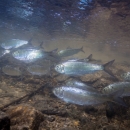What We Do
The Utah Fish and Wildlife Conservation Office was originally established in 1971 to provide fish and wildlife technical assistance to Native American tribes in Utah in order to fulfill its trust responsibility. Our work supports improved fish passage fish passage
Fish passage is the ability of fish or other aquatic species to move freely throughout their life to find food, reproduce, and complete their natural migration cycles. Millions of barriers to fish passage across the country are fragmenting habitat and leading to species declines. The U.S. Fish and Wildlife Service's National Fish Passage Program is working to reconnect watersheds to benefit both wildlife and people.
Learn more about fish passage , fish habitat restoration and the Tribal Wildlife Grants programs.
Management and Conservation
Native Fish & Wildlife Conservation - Conserving imperiled fish and aquatic species and wildlife, (i.e. those in serious decline or listed under the ESA), by planning, coordinating, implementing, and evaluating activities such as habitat restoration and captive propagation and prevent them from being listed under the ESA.
Today, major conservation projects for Utah Fish and Wildlife Conservation Office include restoration of native Bonneville and Colorado River cutthroat trout into streams on the Confederated Tribes of the Goshutes and Northern Ute Indian Reservations in Utah. Activities include conducting fish population surveys; removing nonnative fishes that compete with the trout; constructing fish barriers to exclude nonnative fishes from reentering reclaimed streams; repairing stream side habitat; building fences to keep cattle out of sensitive stream areas; and carrying out stream-side spawning, hatching and rearing of cutthroat trout for reintroduction into restored streams.
Tribal Assistance - Managing natural resources, restoring native species, recovering threatened and endangered species, and restoring habitats to fulfill trust responsibilities.
The Utah Fish and Wildlife Management Assistance Office works with our tribal partners to better manage their fish, wildlife, and habitat resources on 4.5 million acres of Tribal land. This includes managing fish and wildlife resources, restoring native species, recovering threatened and endangered species. In addition, the station provides hands-on learning experiences for Tribal members interested in pursuing fish and wildlife careers.
Federal Lands Assistance - Working with federal land managers, such as the Department of Defense, in rangeland, wildlife and fish management on Federal lands and assisting National Wildlife Refuges to plan, manage, and restore fish, wildlife, and other natural resources.
The Utah Fish and Wildlife Management Assistance Office provides fish and wildlife assistance to the National Wildlife Refuge System through fish, wildlife, and habitat surveys; activities to protect, conserve, and enhance fish and wildlife populations and their habitats; preservation efforts of threatened, endangered, depleted, and native fish species and their habitats; effectively addressing invasive and nonnative species issues; and providing knowledge of baseline fishery and wildlife resources and requirements.
The Utah Fish and Wildlife Management Assistance Office also conducts fish, wildlife, waterfowl, and reptile surveys on 1 million acres of land on Hill Air Force Base. In addition, fishing ponds have been developed and managed on the Air Force Base to provide fishing opportunities for military personnel and their families.


